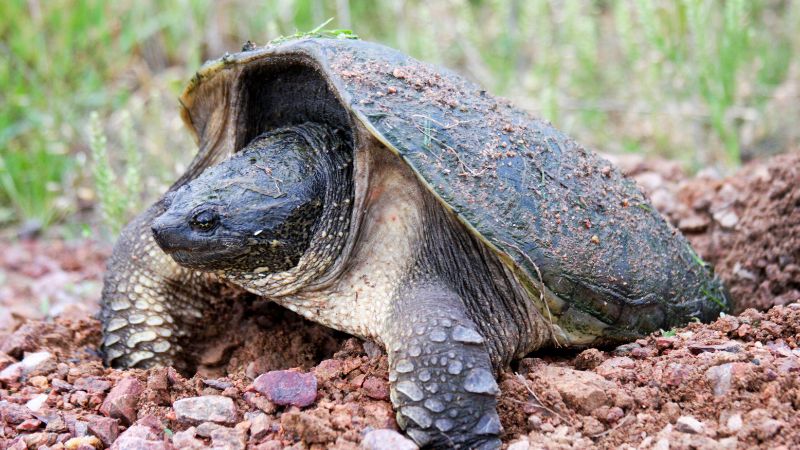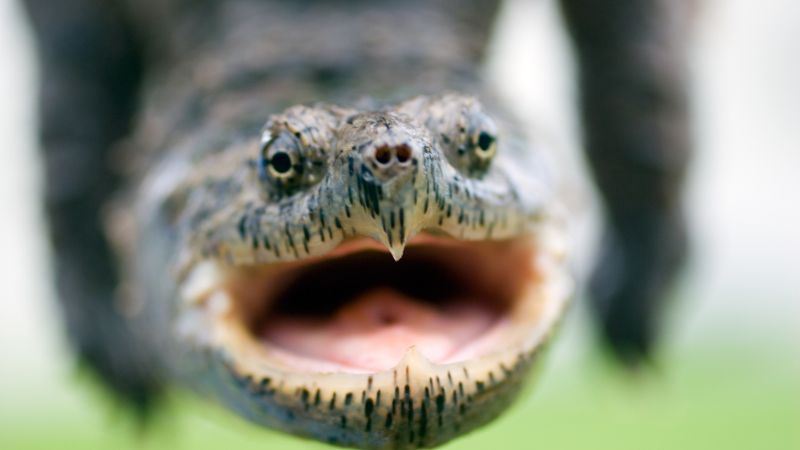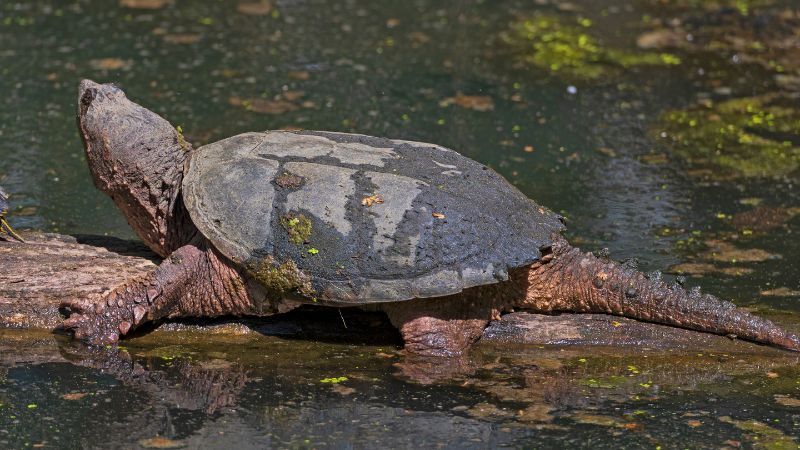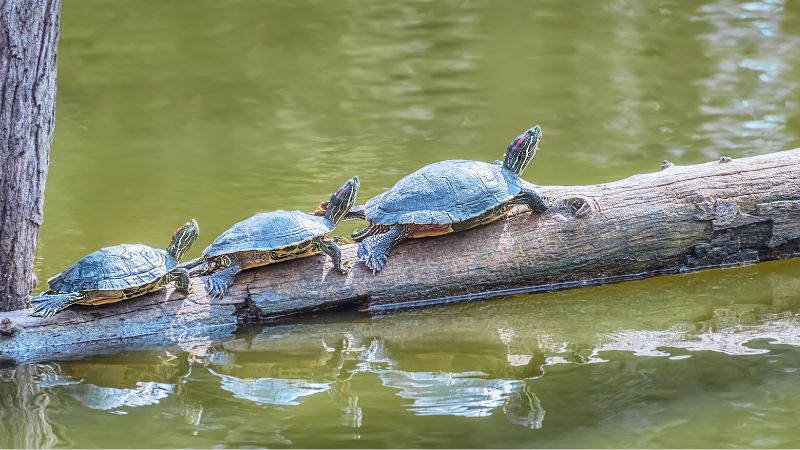There’s a good reason why most people are scared of snapping turtles and it’s because they have powerful jaws capable of biting virtually anything they want to. Thus, removing them from your premises should be a top priority!
So, how to get rid of snapping turtles? Do so by setting up a hook and line or installing traps and then placing these mechanisms in the pond. Use fish or fresh meat as bait and release any unwanted, non-turtle species.
This comprehensive guide will help you identify snapping turtles, get rid of them, and effectively prevent them from ever coming back. Read further for more!
What Are Snapping Turtles?

Snapping turtles (Chelydra serpentina) are large reptiles with huge dark heads, saw-toothed tails, hooked upper jaws, and bony plate-covered shells that range from tan to dark brown. Their legs, necks, and tails are yellow in color.
Unlike other turtles, they’re not fond of basking. Snapping turtles, also fondly referred to as snappers, are highly aquatic animals although they can be spotted on land during the breeding season.
Related: How to Get Rid of Alligators | Safety Measures and Removal Methods
What Do Snapping Turtles Like?
Due to their cold-blooded nature, snapping turtles like spending their time in muddy areas in ponds hidden under the shadows or burrowing into leaf debris during cold temperatures. In the morning, they like to bask under the sun to gather warmth.
What Do Snapping Turtles Eat?
They are opportunistic feeders, which means they consume anything they can get their snapping jaws on. This includes fish, invertebrates, small mammals, birds, amphibians, aquatic vegetation, and even carrion.
Snapping turtles are also known to kill other turtles by means of decapitating their heads. They usually do this to show dominance over their territories.
Where Do Snapping Turtles Live?
They inhabit nearly any type of freshwater habitats but they can also be found in brackish water. Snapping turtles prefer areas with plenty of vegetation and muddy floors.
How Long Does Snapping Turtles Live?
Snapping turtles live up to 30 years in the wild, depending on environmental conditions and if they die as hatchlings. They have a lifespan of up to 40 years in captivity under the right care and maintenance.
How Big Will Snapping Turtles Get?
Their shells range from 8 to 18 inches in length while their tail lengths are nearly the same size. Snapping turtles are large turtles, weighing around 4 to 16 kilograms. Males are usually larger than females.
What Is the Behavior of Snapping Turtles?
Snapping turtles are active during the day and are solitary creatures. They are aggressive when they’re removed from water but will turn docile once they’re put back where they came from.
Males are particularly aggressive and territorial. They capture prey by burying themselves in muddy water then ambushing the unsuspecting animal. They communicate using leg movements and can sense vibrations even in the water.
Related: How to Get Rid of Spiny Softshell Turtles | Effective and Humane Solutions
Is Snapping Turtles Dangerous?

Yes, but only when people try to handle them while they’re on land. In water, they are relatively docile as they choose to avoid contact with humans by swimming away from them.
They have long necks and strong jaws that can snap into your skin and making it extra difficult to remove them without injuring yourself in the process.
Moreover, encountering snapping turtles on land usually happens during the breeding season when they travel by land to find mates. This is also when they’re feeling extra aggressive.
The Pros and Cons of Snapping Turtles in Your Pond
The advantage of having snapping turtles in your pond is helping diversify local biodiversity. Snapping turtles are apex predators in food chains, consuming pesky snakes and other pests. They also help clean waterways by eating animals that are dying or diseased.
However, the disadvantage of having them in your pond is that they may consume game fish and poultry. So if you’re taking care of geese and ducks, it’s definitely dangerous to have snapping turtles in your pond.
Is Controlling Snapping Turtles Necessary?
Yes. Although they’re relatively harmless as long as you avoid picking them up or coming into near contact with them when they’re on land, the same precautions cannot be observed by children and pets.
Not only that but they defecate in water, leading to health problems for humans, pets, and native wildlife.
Signs of Snapping Turtles
One way of telling, aside from sighting the turtles themselves, is if the pond becomes a cloudy or dirtier color than usual. This means their fecal droppings are dirtying up your pond.
Additionally, you may also look for snapping turtle nests in gardens and lawns. Females dig small holes to lay their eggs inside starting around late May to late June.
Should You Get Rid of Snapping Turtles in Your Pond?

Yes. They’re definitely a cause for concern if they inhabit your ponds. Not only are they aggressive once they travel on land, they’re also a health hazard to humans and pets.
How to Get Rid of Snapping Turtles?
Before anything else, make sure you get a go signal from your local wildlife authority. Acquire the necessary permits, if any. Here are some methods to effectively remove snapping turtles from your pond:
Hook and Line Method
Create bank lines by tying 4 to 5 feet of fishing line to a 6 to 8 feet tree limb or flexible pole. Put 12 inches of steel wire between the line and the hook then place the pole far into the pond.
Use cut fish or fresh meat as bait. The best places to set poles are in shallow areas near stumps, plant beds, or under overhanging banks. Release any animals that may have been accidentally caught.
Trapping
Install hoop-net traps to effectively remove snapping turtles in your pond. It must be placed at the bottom of the pond and not suspended in the water.
You can either purchase these barrel-shaped traps or DIY by using square mesh and nylon seine twine. The trap should be 4 to 6 feet long with 3 to 5 hoops of either steel wire or wood.
- Made in USA.
- 4 virtually indestructible Nyglass hoops.
- 2 throats, square in the front, finger throat in the tail.
- Treated with netcoat, a tar solution that helps protect the net...
- #15 nylon netting.
- Perfect design for compact when folded for easy carry. weight:...
- Dimension: Outer diameter 13Inches, Opening length: 75Inches,...
- Ideal design for store and preserve fish in freshwater. It can...
- Material: Net constructed with heavy duty polyester, water and...
- 100% RISK FREE PURCHASE and 100% MONEY BACK SATISFACTION...
Once the turtles are caught, contact a professional to handle and remove them from the premises. Don’t attempt to do it yourself or you will end up being injured.
Related: How to Get Rid of Brown Anole Lizards Naturally | Essential Tips!
How to Prevent Snapping Turtles From Getting Into Your Pond?

The best way to prevent snapping turtles from coming into your pond is to eliminate aquatic vegetation and dredge your ponds to remove muddy bottoms. This makes your pond less attractive to the reptiles.
Additionally, you can also cut or mow pond banks to a 90-degree angle to reduce movement or pathways for snapping turtles. Placing large rocks in potential nesting areas is also effective.
Avoid installing fences as snapping turtles have powerful legs that help them climb even those that are 8 feet in height.
Related: How to Keep Animals Out of Your Garden Without Fence: The Effective Guide
List of Sources
Baldine, M. (2021). Formidable jaws deserve applause.
Bosch, A. T. (n.d.). Chelydra serpentina: Common Snapping Turtle.
Connecticut Department of Energy & Environmental Protection. (n.d.). Common Snapping Turtle.
Missouri Department of Conservation. (n.d.). Common Snapping Turtle Control.
South Carolina Department of Natural Resources. (n.d.). Nongame Device – Hoop Nets.
University of Georgia. (n.d.). Common Snapping Turtle (Chelydra serpentina).
- How to Get Rid of Turtles | Proven Long-Term Solutions! - August 26, 2023
- How to Get Rid of Kingsnakes | Easy & Humane! - August 26, 2023
- How to Get Rid of Northern Water Snakes | Best Solutions and Preventative Measures! - August 19, 2023



